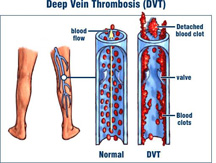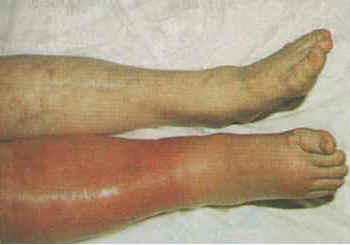A weekly column prepard by Dr Balwant Singh’s Hospital Inc.
By Dr Anirban Banerjee MS, MRCS (Consultant Surgeon)
What is a deep vein thrombosis?
 Deep vein thrombus (DVT) is a blood clot that forms in a deep leg vein. Veins are blood vessels that take blood towards the heart. Deep leg veins are the larger veins that go through the muscles of the calf and thighs. When you have a DVT, the blood flow in the vein is partially or completely blocked, depending on whether the blood clot partially or completely fills the lumen of the vein.
Deep vein thrombus (DVT) is a blood clot that forms in a deep leg vein. Veins are blood vessels that take blood towards the heart. Deep leg veins are the larger veins that go through the muscles of the calf and thighs. When you have a DVT, the blood flow in the vein is partially or completely blocked, depending on whether the blood clot partially or completely fills the lumen of the vein.
Why do blood clots form in leg veins?
Blood normally flows quickly through veins, and does not usually clot. Blood flow in the leg veins is also helped by leg movements. Sometimes a DVT occurs for no apparent reason. However, the following increase the risk of having a DVT:
○ Immobility which slows down the blood flow in the veins.
○ A surgical operation that lasts more than 30 minutes is the most common cause of a DVT. The legs become still when you are under anaesthesia, and blood flow in the leg veins can become very slow.
○ Any illness or injury that causes immobility
● Long journeys by plane, train, etc
● Damage to the internal lining of the vein
● The contraceptive pill and hormone replacement which contain estrogen can increase the risk of DVT.
● People with cancer or heart failure
● Older people are more likely to have a DVT, particularly if you have poor mobility or have a serious illness such as cancer
● Pregnancy
● Obesity
What are the symptoms of a deep vein thrombosis?
 When a blood clot forms, it can either partially or totally block the flow of blood in the vein. Smaller blood clots that partially block blood flow may cause only mild symptoms or none at all. Larger blood clots that block blood flow usually cause leg swelling and pain — often worse when standing or walking.
When a blood clot forms, it can either partially or totally block the flow of blood in the vein. Smaller blood clots that partially block blood flow may cause only mild symptoms or none at all. Larger blood clots that block blood flow usually cause leg swelling and pain — often worse when standing or walking.
Do I need any tests?
Sometimes it is difficult for a doctor to be sure of the diagnosis from just the symptoms as there are other causes of a painful and swollen calf urgently to confirm. Two commonly used tests are:
● The D-dimer test. This is blood test that detects fragments of the breakdown products of a blood clot. The higher the level, the more likely it is that you have a blood clot in a vein.
● An ultrasound scan of the leg which can often detect a clot in a vein.
Is a deep vein thrombosis serious?
It can be. When a blood clot forms in a leg vein it usually remains stuck to the vein wall. The symptoms tend to settle gradually. However, there are two possible complications:
● Pulmonary embolus (a blood clot that travels to the lung).
● Post thrombotic syndrome (persistent calf symptoms).
Pulmonary embolus
In a small number of people who have a DVT, a part of the blood clot breaks off. This travels in the bloodstream and is called an embolus. An embolus can get stuck in a blood vessel going to a lung. This is called a pulmonary embolus.
Post-thrombotic syndrome
Without treatment, up to 6 in 10 people who have a DVT develop long-term symptoms in the calf. This is called ‘post-thrombotic syndrome.’ Symptoms like calf pain, discomfort, swelling, and rashes can occur. An ulcer on the skin of the calf may develop in severe cases.
What is the treatment for a deep vein thrombosis?
Anticoagulation
Anticoagulation is often called ‘thinning the blood.’ However, it does not actually thin the blood. It alters certain chemicals in the blood to stop clot formation. This prevents a DVT from getting larger, and prevents any new clots from forming.
Compression and raising the leg
If the DVT was in a thigh vein, you may be advised to wear a compression stocking. This treatment reduces the risk of developing post-thrombotic syndrome. You should wear the stocking each day, for at least two years. In addition you may be asked to raise your leg when you are resting and raise the foot end of the bed a few inches.
Preventing a first DVT or a recurrence of a DVT
A DVT is often a ‘one-off’ event after a major operation. However, some people have an ongoing risk of a further DVT. Other things that may help to prevent a first or recurrent DVT include the following:
● If possible, avoid long periods of immobility.
● Major surgical operations are known to be a risk for a DVT, particularly operations to the hip, lower abdomen and leg.
What is travel-related DVT?
Long journeys (more than four hours by plane, etc,) are thought to cause a slightly increased risk of DVT. This is probably due to sitting immobile and cramped for long periods. In plane journeys, in addition to the immobility, other factors which may possibly play a part (but are not proven) include: the reduced cabin pressure; reduced oxygen levels in the plane; slight dehydration caused by not drinking much water, and drinking too much alcohol.
What can I do to reduce the risk of travel-related DVT?
● Exercise your calf and foot muscles regularly:
● Every half hour or so, bend and straighten your legs, feet and toes.
● Press the balls of your feet down hard against the floor or foot-rest every so often. This helps to increase the blood flow in your legs
● Take a walk up and down the aisle every hour or so, when the aircraft crew say it is safe to do so.
● Drink plenty of water.
● Do not drink too much alcohol.
● Do not take sleeping tablets, which cause immobility.
● Consider wearing compression stockings.
● Some people at risk may also be advised to take anticoagulant medication.








